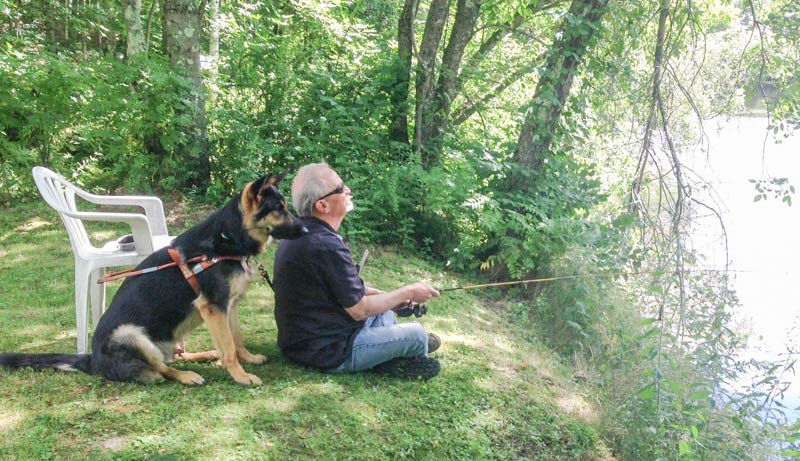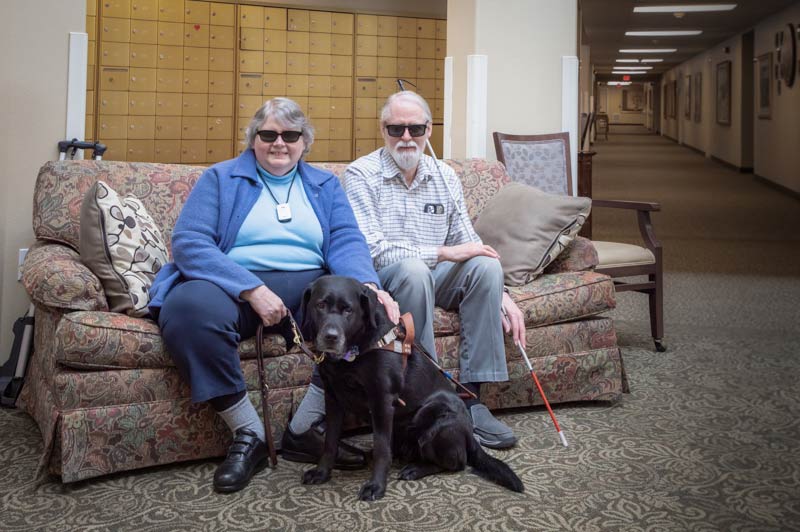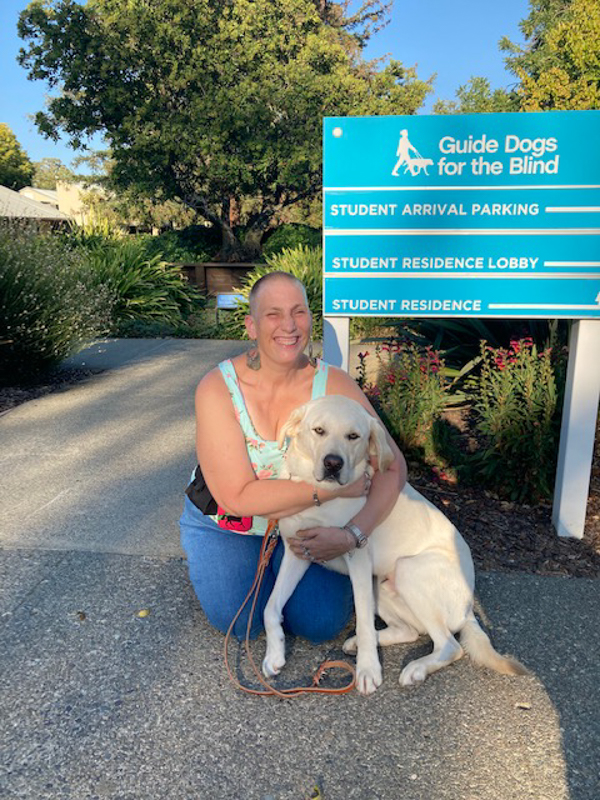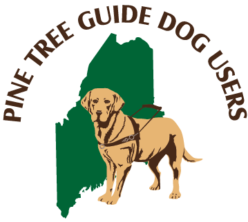Meet Maine’s Guide Dog Handlers
A Partnership Like No Other
Preparing for a Guide Dog
Guide Dogs in Action
What to Do When You Meet a Guide Dog Team
Guide Dog Training Programs
The End of a Partnership

Meet Maine’s Guide Dog Handlers
From the urban sprawl of Maine’s cities to the quiet beauty of its countryside, guide dog handlers are contributing members of their families, communities and places of employment. They range in age from 16 to senior citizens, and their home environments may be rural or urban. But they all have this in common: They lead full rewarding lives, greatly enhanced through the use of their specially trained guide dogs.
Read our personal stories about guide dogs, vision loss, and more.
A Partnership Like No Other
A successful partnership between a blind person and a guide dog blends both human and canine skills. Each member of the team has certain responsibilities. The dog knows guide work and the handler knows how to travel independently and they both know how to work together. The end result is an extraordinary relationship of love and trust in which the safety and well-being of each other is paramount.
Preparing for a Guide Dog
Vision loss may be gradual or sudden, occur at birth or later in life, and may be the result of a genetic condition, a disease or an accident. The person may have partial vision, or none at all. But no matter the circumstances, a prerequisite to working with a guide dog is learning how to move safely, efficiently, and effectively from one place to the next, such as being able to walk without tripping or falling, cross streets, or use public transportation. It’s also the guide dog handler’s responsibility to know where to go and how to get there. Independent travel skills are essential for working with a guide dog.
Find out how you can get Orientation and Mobility instruction to develop independent travel skills

Guide Dogs in Action
The success of a guide dog is not a matter of luck or chance. Guide work requires the dog to have specific skills to safely and efficiently guide someone who is blind. They must remain alert and stay focused on their surroundings at all times. They know to avoid both stationary and moving obstacles such as trash cans, overhanging limbs, pedestrians, and oncoming traffic. They make the handler aware of nearby stairs, curbs and other changes in the ground’s surface, and they refuse to move forward if danger lies ahead.
Check out our Guide Dogs in Action Educational Series
But it’s not all work and no play for a guide dog. When the dogs are not in harness, they act much the same way as ordinary pets. They might race around the yard with other dogs, chew on a favorite toy, or snuggle up in a cozy spot with their handler. Essentially, when the harness is removed, guide dogs understand that they are “off-duty” and behave accordingly.
What to Do When You Meet a Guide Dog Team
Tempting as it may be to pet, feed, make eye contact with, talk to or otherwise interact with the guide dog, remember that the dog is responsible for leading someone who cannot see. It should never be distracted from that work. Likewise, trying to guide the team by holding onto the dog’s harness or leash, or allowing a pet to come too close to the guide dog can also be unsafe. In short, the best thing to do when you meet up with a guide dog team is to give a friendly greeting to the handler and just ignore the dog. A simple “hello” not only alerts the handler of your presence but can also provide an opportunity for the handler to engage in conversation with you or request assistance if needed.
More about tips on guide dog etiquette
Guide Dog Training Programs
While a limited number of guide dogs are privately trained, most guide dogs are specially bred, raised and trained by guide dog training schools accredited by the International Guide Dog Federation.
Check out the guide dog School surveys to see which school is right for you.
From an early age, guide dog puppies are prepared for their life’s work. At about eight weeks old, they are placed with volunteer puppy raisers who give the pup love and affection, teach basic obedience, and expose the dog to many social situations and environments that they are likely to come across when they become a guide dog.
At about 15 months of age, puppies return to the guide dog school where they are formally trained in all aspects of safely guiding a blind person. From there, they are carefully matched with their new owners who in turn, undergo specialized training in the use and care of their new guide dogs. This final stage of training takes place in group classes at the guide dog school or at home within the community where the person lives. After graduation, the school provides ongoing support to its alumni and their dogs as needed.

The End of a Partnership
Every day, the lives of blind people are enhanced by the unique abilities and devotion of their specially trained guide dogs. Sadly, the working life of a guide dog is finite. At some point, almost every handler will face the heartbreaking day when the dog will no longer be able to work.
Deciding when it’s the right time for the dog to retire is the first, and often most difficult, step of the whole retirement process. For handlers, it means accepting the hard truth that their primary means of independent travel will no longer be available to them. Even when handlers choose to retrain with a new dog, it can take months for the guide dog school to find just the right match. It can also be a bit daunting to think about starting the process all over again with a successor guide dog that has not yet developed the deep personal bond previously shared with the retired dog, or familiarity with the handler’s most frequented routes or destinations.
Read this touching letter of farewell to a beloved guide dog.
Retiring a guide dog can be a tremendous source of grief for the handler as well as for other members of the household. The need to retire a trusted partner can occur as a result of the dog’s natural aging, a medical condition, a traumatic event or some other circumstance. When the time comes, handlers may choose to keep their retired dog as a pet. But for some, retirement means finding the dog a new home. This may be due to financial limitations, housing restrictions on pets, or other barriers that make it difficult, if not impossible, to maintain ownership of the dog. In these instances, handlers may rehome the guide dog with a family member, a friend, the guide dog school, the dog’s puppy raiser, or others who they believe will provide the best home possible.
The death of a guide dog can also be cause for significant grief. In much the same way that pet owners mourn the loss of a cherished pet, guide dog handlers also experience intense feelings of sorrow and pain when their beloved guide dog is gone. In addition to the heartache, handlers may be left without their preferred method of independent travel if the dog was still working before its death.
As time passes, the grief will ease, and healing will take place. Handlers will eagerly await the day when they meet and train with their new partner. And together, they will embrace the world anew, free to travel safely and independently anywhere they wish to go.
